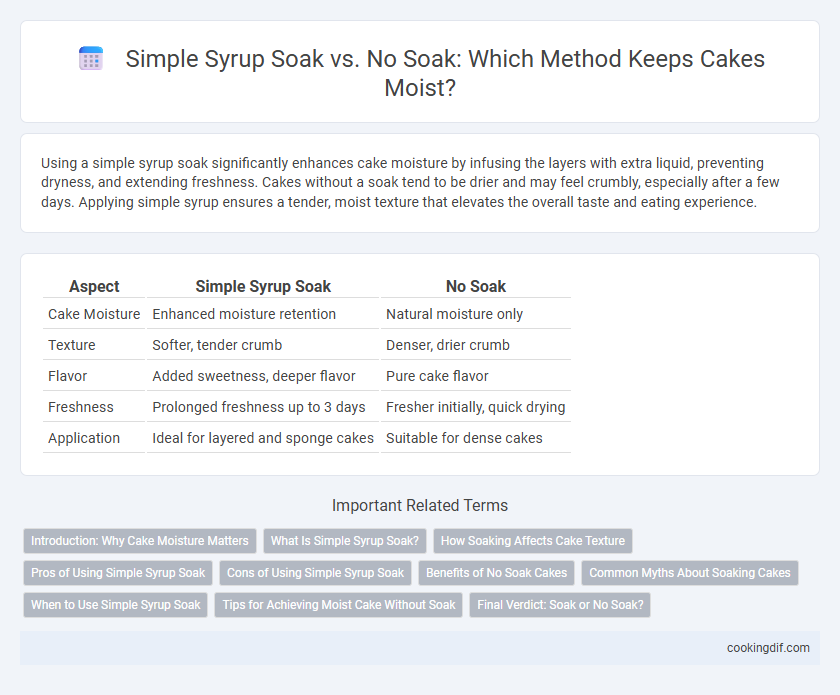Using a simple syrup soak significantly enhances cake moisture by infusing the layers with extra liquid, preventing dryness, and extending freshness. Cakes without a soak tend to be drier and may feel crumbly, especially after a few days. Applying simple syrup ensures a tender, moist texture that elevates the overall taste and eating experience.
Table of Comparison
| Aspect | Simple Syrup Soak | No Soak |
|---|---|---|
| Cake Moisture | Enhanced moisture retention | Natural moisture only |
| Texture | Softer, tender crumb | Denser, drier crumb |
| Flavor | Added sweetness, deeper flavor | Pure cake flavor |
| Freshness | Prolonged freshness up to 3 days | Fresher initially, quick drying |
| Application | Ideal for layered and sponge cakes | Suitable for dense cakes |
Introduction: Why Cake Moisture Matters
Cake moisture significantly impacts texture, flavor, and overall eating experience, making it a crucial factor in baking. Using simple syrup soak enhances moisture retention by infusing liquid evenly throughout the cake layers, preventing dryness and improving softness. In contrast, no soak may result in a drier, denser cake, especially in recipes with longer shelf life or lean ingredients.
What Is Simple Syrup Soak?
Simple syrup soak is a technique where a sugar and water solution is brushed or poured onto cake layers to enhance moisture and extend shelf life. Unlike not soaking, which can result in dryer cake, simple syrup soak penetrates the crumb for a tender, moist texture. Bakers often flavor the syrup with extracts or liqueurs to complement the cake, making it both moist and flavorful.
How Soaking Affects Cake Texture
Soaking cake layers with simple syrup significantly enhances moisture retention, resulting in a softer and more tender crumb. Cakes without soaking tend to dry out faster, leading to a denser and crumbly texture. Properly applied simple syrup soaks create a delicate balance by adding moisture without making the cake soggy, improving overall mouthfeel and freshness.
Pros of Using Simple Syrup Soak
Using simple syrup soak enhances cake moisture by infusing liquid directly into the crumb, preventing dryness and extending freshness. It creates a tender texture and intensifies flavor absorption, resulting in a richer taste experience. Applying simple syrup also improves cake durability, making it ideal for layered or decorated cakes that require longer display times.
Cons of Using Simple Syrup Soak
Using simple syrup soak in cakes can lead to an overly moist texture that compromises structural integrity, causing layers to become soggy or collapse. Excessive moisture from the syrup may dilute the cake's flavor profile, resulting in a less rich and balanced taste experience. Additionally, simple syrup adds extra sugar, which can make the cake overly sweet and reduce its overall freshness over time.
Benefits of No Soak Cakes
No soak cakes retain their natural crumb texture and are less prone to becoming overly soggy or unstable during storage. By avoiding simple syrup soak, the cake maintains a balanced moisture level that enhances the flavor integrity and provides a lighter mouthfeel. This method also reduces preparation time, making no soak cakes ideal for quick assembly without sacrificing moistness.
Common Myths About Soaking Cakes
Many believe that soaking cakes with simple syrup is unnecessary and can make the cake soggy, but using simple syrup actually enhances moisture retention by penetrating the crumb without overpowering texture. Another common myth is that cakes baked perfectly moist don't require soaking; however, even well-baked cakes benefit from syrup to extend freshness and improve flavor absorption. Avoiding simple syrup soak often results in drier cakes that lose softness faster, especially for cakes with lean batters or layers prone to drying out.
When to Use Simple Syrup Soak
Simple syrup soak is ideal for cakes that are prone to dryness or have dense crumb structures, such as pound cakes or sponge cakes, to enhance moisture retention and improve texture. Cakes with naturally moist ingredients, like butter or oil-based recipes, often do not require soaking, as they maintain sufficient internal moisture. Applying simple syrup soak immediately after baking and cooling locks in moisture, ensuring the cake remains tender and flavorful for extended periods.
Tips for Achieving Moist Cake Without Soak
To achieve a moist cake without using a simple syrup soak, incorporate ingredients that naturally retain moisture, such as sour cream, yogurt, or oil. Bake the cake at the correct temperature and avoid overbaking by testing doneness early, which helps prevent dryness. Wrapping the cake in plastic wrap or storing it in an airtight container immediately after cooling locks in moisture for a tender crumb.
Final Verdict: Soak or No Soak?
Using a simple syrup soak significantly enhances cake moisture by preventing dryness and extending freshness, especially for layered or sponge cakes. Cakes without a soak tend to dry out faster, particularly in drier environments or after refrigeration. For optimal texture and flavor retention, applying a simple syrup soak is the recommended method to ensure a moist and tender cake.
Simple syrup soak vs No soak for cake moisture Infographic

 cookingdif.com
cookingdif.com